The AIADMK is in a classic Catch-22 situation in Tamil Nadu: the party is damned if it allies with the BJP, and damned if it does not.
On the one hand, to consolidate the anti-DMK votes and remain electorally competitive, the AIADMK feels compelled to ally with the BJP. This pragmatic move will prevent a fatal split in the Opposition vote that would almost certainly benefit the ruling DMK-led coalition. On the other, aligning with the BJP to strengthen its electoral position simultaneously weakens the AIADMK’S core identity. This alienates a crucial segment of its traditional voter base, as long-time AIADMK supporters, particularly from minority communities as well as Dravidian adherents, view the BJP’s Hindutva ideology as antithetical to the party’s foundational principles.
Meanwhile, the alliance, meant to bolster the AIADMK, provides the BJP with the platform and legitimacy it needs to grow in Tamil Nadu. This growth often comes from poaching voters directly from the AIADMK itself. Specifically, the BJP attracts those who have looser ties with the AIADMK’s ideological past but have aligned with the party primarily because they oppose the DMK.
And if the AIADMK were to break the alliance to protect its ideological core and win back disaffected voters, it would likely face a multi-cornered contest. This would splinter the anti-DMK vote, making a DMK victory mathematically much easier.
The path that the AIADMK has chosen in an attempt to solve its short-term electoral problem — namely, allying with the BJP — deepens its long-term existential crisis of losing its unique identity and voter base. The path to electoral survival seemingly requires an act of political self-harm. This is the perfect definition of a Catch-22. The vote share data in Table 1 A and B from the past decade shows contested vote share from Assembly and Parliamentary elections.
The numbers bear this out. While the votes shares of the AIADMK significantly dropped from 2011 to 2021, the party retained a strong core of close to 40% of votes in the seats it contested in 2021. This dropped dramatically to 23.5% in the 2024 Lok Sabha elections, when the AIADMK opted to stay out of the BJP-led alliance.
In an earlier Data Point titled ‘AIADMK and BJP split: Diminishing electoral returns…’ in October 2023, we had advanced the reasons for the regional party’s decision to move away from the BJP because a significant core of its voters were uncomfortable with the alliance. Meanwhile, the BJP’s performance in urban local body elections held closer to that time showed that the party improved its vote share largely at the expense of the AIADMK.
The 2024 parliamentary elections — viewed with the caveat that these were held to decide equations in New Delhi rather than in Chennai — also showed that the BJP was capable of gaining ground at the expense of the AIADMK.
Meanwhile, the DMK-led alliance — an ideologically coherent front bound by its opposition to the BJP — retained its vote share between 2021 and 2024, enhanced by around 2% points following the support of Kamal Haasan’s party.
Data in Tables 2A, B, and C, however, complicates the picture. While the AIADMK in its alliance with the BJP won close to 75 Assembly seats in 2021, the split between the two parties resulted in the DMK leading in 221 Assembly segments in the 2024 parliamentary elections. This left the AIADMK-led alliance and the BJP-led alliance to lead in just 10 and 3 segments, respectively.
Hypothetically, if the alliance between the AIADMK, the BJP, and their respective partners had remained intact, they would have led in 84 segments. This would have placed the alliance’s hypothetical 41% vote share just 6 points behind the ruling coalition’s 47%, a gap that a 3-point swing could potentially bridge.
A region-wise break-up (Table 3 A and B) gives a more granular picture. In the West, or the Kongu belt from where AIADMK chief Edappadi K. Palaniswami hails, the combined alliance had won 26 out of 42 seats in 2021. In the North-Central region, where the PMK is a strong party, they won 24 of the 55 seats. These numbers were reduced to just 2 (for AIADMK+) and 7 (four for AIADMK+ and three for BJP+) segments, respectively, in the 2024 elections.
If these parties had maintained their 2021 alliance, they would have led in 22 segments in the West (as opposed to 20 for the DMK-led coalition) and 29 in the North-Central region (against 26 for the DMK+). The combined coalition would have also led the DMK+ 15-14 in the South. This explains why AIADMK leaders from the West and some in the South have given statements favouring an alliance with the BJP, while the PMK president stated his preference for an alliance with the AIADMK in 2024.
The internecine strife within the PMK and the DMDK’s new-found ambivalence are challenges for the AIADMK-BJP coalition too.
A further complication for the 2026 Assembly elections is the entry of actor Vijay’s TVK. An alliance with the TVK might seem a logical way for Mr. Palaniswami to consolidate anti-DMK votes, but two factors complicate this. First, the strength of the TVK’s support base remains purely speculative. Second, the AIADMK’s influential western leaders continue to push for closer ties with the BJP. Caught between these pressures, the beleaguered leader appears to have chosen to return to the BJP coalition even though it will likely hurt his party’s identity in the long run.
Published – July 24, 2025 08:00 am IST
